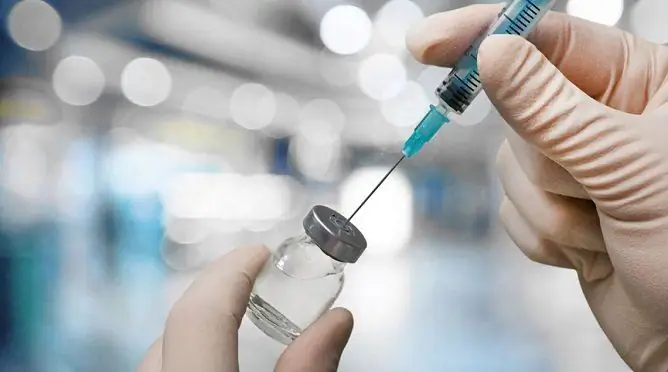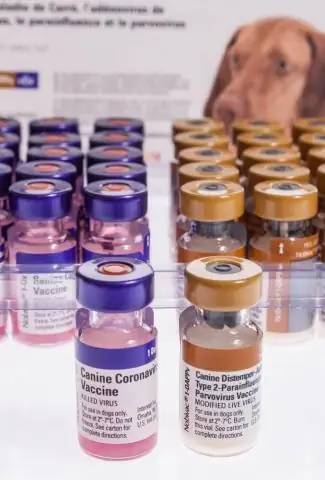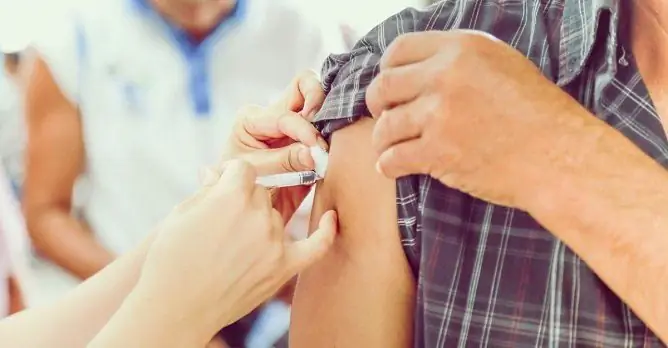- Author Rachel Wainwright [email protected].
- Public 2024-01-15 19:51.
- Last modified 2025-11-02 20:14.
Chickenpox vaccination: indications, contraindications, side effects
The content of the article:
-
Characteristics of the varicella-zoster virus
Chickenpox pathogenesis and symptoms
- Prevention of chickenpox
-
Chickenpox vaccines
Effectiveness of vaccination
- Indications
- Vaccination regimens and route of administration
- Contraindications
- Side effects of chickenpox vaccination
- Herpes zoster vaccine
- Video
Vaccination against chickenpox is the most effective way to protect a child from infection with the Varicella Zoster virus (the causative agent of chickenpox and herpes zoster) and to prevent a severe course of the disease, life-threatening complications in contact persons.

The most effective way to protect against chickenpox is to get vaccinated
The existing antiviral drugs for the treatment of chickenpox are not able to prevent dangerous complications and consequences of the disease and protect against herpes zoster in the future.
All preventive vaccinations are divided into:
- mandatory (included in the national calendar);
- for health reasons (patients at risk);
- for epidemiological reasons (living in an area where outbreaks of diseases for which a vaccine exists);
- recommended (at the request of the child's parents or the patient himself).
In Russia, vaccination against chickenpox is included in the list of recommended or can be carried out for health reasons. Vaccinations are available at private clinics.
Characteristics of the varicella-zoster virus
Chickenpox is an extremely contagious infectious disease and is common throughout the world.

The causative agent of the pathology is the Varicella Zoster virus
The causative agent of the pathology - herpesvirus, can affect only humans. Outside the body, it is unstable (remains viable for 10-30 minutes), quickly dies when heated, exposed to sunlight, disinfectants. Freeze resistant.
Only someone with symptoms of chickenpox or herpes zoster can spread the virus.
Virus infection routes:
- drip (contact of infectious particles on the mucous membranes when sneezing, coughing);
- contact (transfer of the virus upon contact with the contents of the vesicles - pockmarks);
- vertical (penetration of Varicellavirus through the placenta).
The probability of becoming infected by contact with a person shedding the virus is 90-95%. Babies up to 6 months old, born to mothers who had chickenpox in childhood, are immune to the virus (there are sufficient maternal antibodies in their blood).
Varicellavirus has the ability to penetrate the nervous system, especially into the sensory and autonomic ganglia along the spinal cord, which are inaccessible to the cells of the immune system. After the symptoms of the disease disappear, the pathogen goes into hibernation and, under favorable circumstances, can cause herpes zoster.
Chickenpox pathogenesis and symptoms
Varicella-zoster has a tropism (easily penetrates and multiplies) to lymphocytes, epithelial cells of the mucous membranes, and nervous tissue. This pathogen is able to escape the immune response, hiding inside these cells, which allows it to multiply rapidly, accumulate, breaking the cell, enter the bloodstream and spread throughout the body.

A rash is a characteristic symptom of the disease.
The incubation period for chickenpox is on average 2 weeks (5 to 21 days). The first symptoms appear from the moment the virus enters the bloodstream.
Chickenpox symptoms:
- increased body temperature;
- intoxication (general weakness, loss of appetite, nausea, drowsiness);
- typical skin rashes.
Characteristics of a rash with chickenpox:
- rash appears in the first 24 hours after the onset of the fever;
- the amount increases jerky, accompanied by a new rise in body temperature, intense itching.
The rash goes through several stages of development. The pathology is characterized by false polymorphism (on one area of the skin there are all stages of rashes).
Stages of rashes with chickenpox:
| Rash element | Characteristic |
| Spot | Rounded, painless, unconsolidated redness of the skin, caused by local expansion of capillaries |
| Papule | A bump (serous edema of the skin) that rises above the surface of the skin |
| Vesicle | A superficial cavity element that rises above the surface of the skin and contains serous fluid inside. The vesicle is unicameral, the cover is thin. Looks like a dewdrop on the skin surrounded by a rim of redness |
| Pustule | The same vesicle, only the liquid inside is cloudy, and the tire is more compacted, sluggish |
| Crust | A dense brown mass that forms from a secreted vesicle or pustule and covers the healing site |
The rash period lasts up to 6 days. The last crusts fall off after 20-23 days.
Adults tolerate the disease much more difficult, with severe intoxication and frequent complications.
Complications with chickenpox occur in 5-30%:
- bacterial skin infections;
- pneumonia;
- acute otitis media;
- purulent conjunctivitis;
- urinary tract infection;
- acute cerebellar ataxia (inability to stand upright, walk);
- meningitis;
- encephalitis;
- hepatitis;
- thrombocytopenia.
In patients with reduced immunity or severe chronic diseases, complications occur in 50% of cases.
Treatment of mild disease is symptomatic (control of fever, relief of itching, and prevention of bacterial skin infection). In some cases, antiviral drugs are prescribed (Acyclovir in tablets or injections for 7-10 days).
Prevention of chickenpox
In 80 countries around the world, the chickenpox vaccine has been introduced into the mandatory vaccination calendar, which gives almost 100% protection against Varicella Zoster infection.
Vaccination can be done routinely or urgently to contact persons within 5 days.
Also, passive prophylaxis with varicella-zoster immunoglobulin is possible within 96 hours after contact with a sick person. But it is administered mainly to people with reduced immunity, newborns whose mothers had chickenpox before childbirth, or pregnant women. Immunoglobulin does not protect against infection with the virus throughout life and does not replace the vaccine.
Chickenpox vaccines
To date, there are three types of vaccinations that contain varicella-zoster:
- monovaccine (Varilrix, OkaVaks, Varivaks);
- combination vaccine for chickenpox, measles, mumps and rubella (MMRV);
- vaccine for the prevention of herpes zoster (ZVL, Zostavax).
All of these vaccines are live attenuated Oka strain Varicellavirus. The difference is how many units of the virus are in one dose. In the monovaccine - 1350 PFU (plaque-forming units), the combined - 9772, and in the vaccine against herpes zoster - at least 19,400.

Varilrix contains live attenuated Varicellavirus
Two vaccines are registered in Russia:
- Varilrix: manufactured by GlaxoSmithKline, Belgium;
- OkaWax: manufactured by Sanofi Pasteur, France.
Effectiveness of vaccination
After one dose of vaccination, specific antibodies appear in 97% of children, after the second - in 100%. Among those vaccinated over the age of 13, the figures are 78 and 99%, respectively.
As a result, vaccination against chickenpox in 90% of cases protects against infection with the virus and in 100% - against severe disease and complications.
In those rare cases, when the vaccinated child still gets sick, the infection proceeds in a mild form: without high fever, rash elements - usually no more than 50 (they do not develop to vesicles).
Indications
In Russia, on an individual basis (optional), the vaccine is received:
- children from 9 months;
- adolescents and adults who have not previously had chickenpox;
- patients who have been in contact with a patient with chickenpox (up to 5 days);
- health and education workers;
- women who are planning a pregnancy, but have not had chickenpox before;
- patients with a high risk of complications (leukemia requiring treatment with corticosteroids, organ transplants, chronic renal failure, bronchial asthma, atopic dermatitis, autoimmune diseases).
Vaccination regimens and route of administration
It is optimal to vaccinate at the age of 12-24 months. The completed course is considered after the introduction of two doses with an interval of 6 weeks. All vaccines that contain varicella-zoster are injected strictly subcutaneously into the deltoid area or the front of the thigh. One immunizing dose is 0.5 ml.

The vaccine can be injected into the deltoid area
When administered simultaneously with CPC and other vaccinations (except BCG), it does not lose its effectiveness and safety. The only rule is that each vaccine should be administered in a separate area of the body.
Vaccines from different manufacturers are interchangeable. That is, if the first dose was Varilrix vaccination, then the second one could be OkaVax and vice versa.
It is not recommended to use drugs containing salicylic acid for 6 weeks after the vaccine was administered, due to the high risk of developing Reye's syndrome.
Contraindications
Contraindications to vaccine administration:
- severe immunodeficiency (congenital or acquired);
- HIV;
- hypersensitivity to the components of the drug;
- pregnancy (theoretically, the virus can cause congenital chickenpox syndrome of the fetus);
- lactation period;
- acute infectious diseases with severe fever;
- treatment with high doses of corticosteroids (more than 1 mg / kg for children, 20 mg per day for adults);
- transfusion of blood, plasma, administration of immunoglobulins less than 5 months old.
Vaccinated women should avoid pregnancy for 4 weeks.
Side effects of chickenpox vaccination
In most healthy people, the procedure is well tolerated, post-vaccination reactions are limited to local swelling, redness at the injection site during the first hours after injection (25%). In one case out of 50, a mild course of chickenpox with single rashes may be observed.
Other complications after vaccination (less than 1 case in 1000):
- lymphadenopathy;
- headache, drowsiness;
- upper respiratory tract infection;
- rash;
- hives;
- muscle and joint pain.
Herpes zoster vaccine
In 2 out of 10 patients who have had chickenpox, further exacerbations of herpes zoster are observed. The peak incidence occurs at the age of over 50.

In adults, vaccination is necessary to prevent herpes zoster
Herpes zoster causes the following complications:
- postherpetic neuralgia (severe pain along the affected nerve endings);
- cranial nerve palsy;
- hemiplegia;
- deterioration of vision (with damage to the trigeminal nerve).
The vaccine is administered once, subcutaneously. It contains the same virus strain as for chickenpox, but at a much higher concentration. This method of prevention reduces the likelihood of episodes of the disease by 60%. It also reduces the likelihood of developing postherpetic neuralgia and the intensity of pain in people who, after vaccination, still develop herpes zoster.
Video
We offer for viewing a video on the topic of the article.

Anna Kozlova Medical journalist About the author
Education: Rostov State Medical University, specialty "General Medicine".
Found a mistake in the text? Select it and press Ctrl + Enter.






